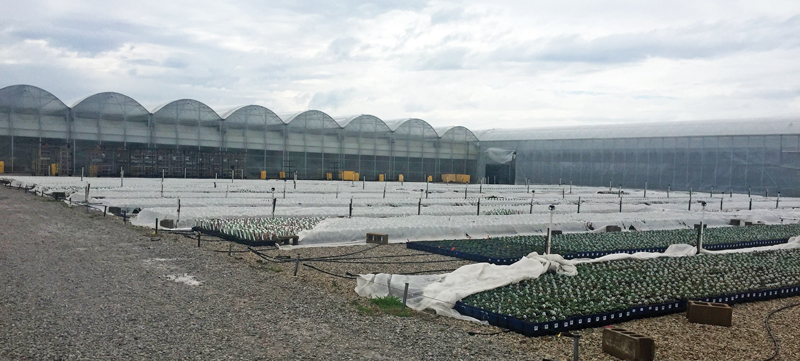12/1/2019
All Bundled Up
Paul Pilon

In the October issue, I discussed several aspects of growing perennials in the fall to better prepare them for winter. So now that snow has fallen in many states and winter begins in December, I thought it would be fitting to cover some aspects of successfully overwintering perennials in this month’s column.
Pictured :It’s important to let plants have lots of exposure to cold temperatures to ensure they get acclimated prior to covering them with protective blankets.
I receive numerous questions from growers across the country and Canada about how to successfully overwinter perennials. Unfortunately, there’s not one recipe that applies to all growers, but there are some common themes I’d like to pass along.
Cold protection: One of the most important aspects of successful overwintering is to provide adequate protection from cold. This looks different for growers in different geographic locations. For example, a Southern grower may be able to successfully overwinter perennials with minimal or even no cold protection. Conversely, a Northern grower will need to provide very elaborate and often extensive amounts of cold protection.
Cold hardiness: It’s important to note that the hardiness listed on the plant tag reflects the plants hardiness in the landscape and doesn’t accurately reflect its ability to withstand cold while it’s being grown in a container. A good general rule of thumb is to add one hardiness zone to the zone the plant is listed in. For example, a Zone 5 plant in the landscape is a Zone 6 plant in a container. This means some perennials may require more cold protection than you think.
Protective blankets: Besides overwintering perennials inside structures, using protective blankets is the most common method of protecting plants from freezing temperatures. The question is: When do you cover crops? Unfortunately, there isn’t one answer to this question either. I prefer to wait as long as possible before covering perennials for the winter. It’s important to let the plants have lots of exposure to cold temperatures to ensure they get acclimated prior to covering them with protective blankets. The blankets are intended to protect plants from the coldest periods of the winter and aren’t usually necessary at the onset of cold weather. Covering them too early could delay acclimation and result in plants that are cold-sensitive even though they’re under blankets.
Evergreen perennials: Like many things in life, there are always a few exceptions. Earlier, I said to wait as long as possible to cover perennials and that it’s not as important to protect plants when cold temperatures first occur. In many instances, evergreen perennials are the exception. If the fall temperatures decrease gradually over time, evergreen perennials can be protected very similarly to herbaceous perennials that go fully dormant. However, if the fall temperatures are warm and the plants don’t have sufficient time to be acclimated to cold and a sudden drop in temperature occurs, then protective covers can be helpful to prevent frost damage.
Moisture levels: Proper moisture levels are very important during the overwintering period. It’s not that the perennials are using much, if any, water during dormancy, but water plays an important role in protecting the roots from freezing temperatures. I don’t like to see overly wet and saturated conditions, but I also don’t like to see overly dry root systems during the winter months. Keep the moisture levels slightly above the midpoint between overly wet and overly dry.
Fertility: Most perennials aren’t actively taking up nutrients when they’re not actively growing and dormant. Therefore, it’s generally not necessary to apply fertilizer during dormancy. Having said that, the nutrient levels shouldn’t be zero. I’ve observed countless instances where plants with some fertility during the winter looked and performed better after dormancy than plants that had very low fertility levels. This certainly holds true for evergreen perennials. I’m aware of several growers who intentionally maintain some fertility in the soil throughout the winter months, albeit relatively modest compared to the amounts being delivered when the plants are actively growing.
Rodents: Don’t underestimate the amount of damage and crop losses rodents can cause during the overwintering period. In some instances, certain methods can be implemented to exclude or to repel them, but most growers find it best to use anti-coagulant or single dose baits to reduce feeding injury and to control rodents. If using baits, keep them dry, as moisture reduces their effectiveness and follow each product’s recommendations for bait placement and other guidelines to maximize efficacy. Growers must use great caution when using commercial baits, as they’re toxic to all forms of animal life. Pets, such as dogs, can become extremely sick and even die when they consume rodent baits.
Overwintering isn’t a given. It can be scary and does carry some risk. However, with the right planning, management practices and cold protection, overwintering perennials can be done successfully. I, for one, don’t particularly care for cold, so like my perennials, I’ll be all bundled up to minimize my exposure and risk of frostbite. Hopefully, you’ll give your perennials the proper protection from cold, too. GT
Paul Pilon is a Perennial Production Consultant and editor-at-large of the Perennial Pulse e-newsletter. Feel free to contact him with article topics or to address your perennial production challenges. He can be reached at paul@perennialsolutions.com.